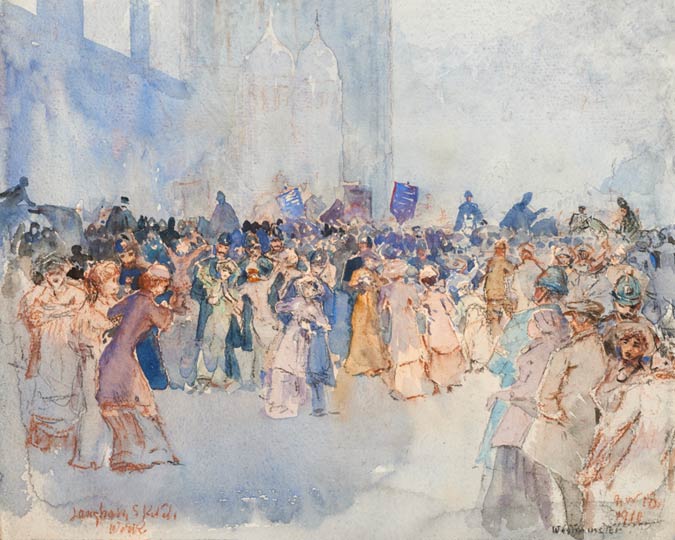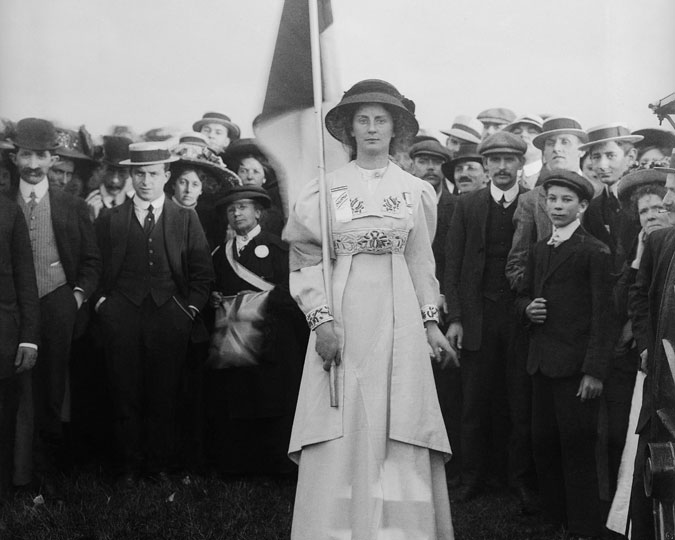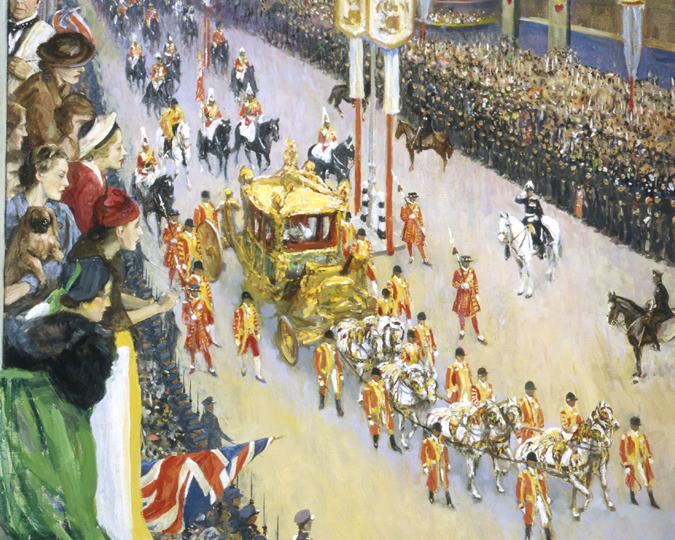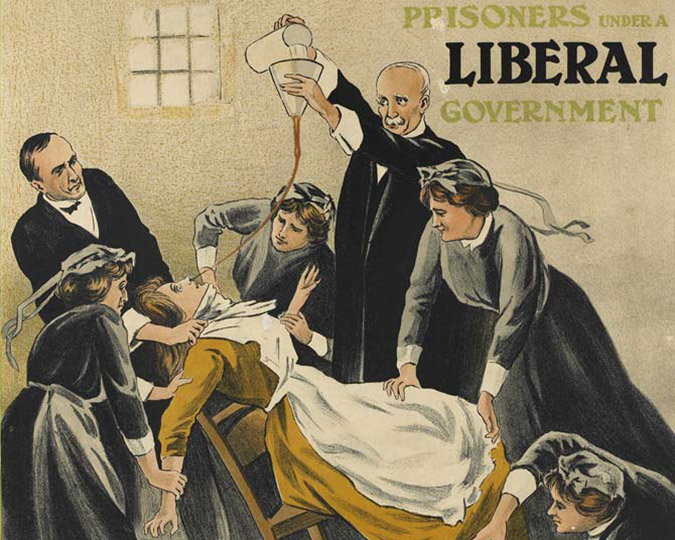The year 1911 saw a unique coronation procession in London. Just before the coronation of George V, around 40,000 people from across the British Isles marched the streets of London demanding ‘Votes for Women’.
What was the coronation procession about?
The Women's Coronation Procession was organised by the Women’s Social and Political Union (WSPU) in central London on 17 June 1911. This spectacular procession was held a week before the coronation of George V with the intention of enlisting the support of the new King for the proposed Conciliation Bill. This Bill, due to be debated in Parliament, proposed to introduce the parliamentary franchise for women who were responsible for the premises they occupied.

(left) A poster advertising the Women’sCoronation Procession, and Suffragette leaders Emmeline Pankhurst, Christabel Pankhurst, Mabel Tuke and Emmeline Pethick-Lawrence on 17 June 1911. (ID nos: NN23735; 50.82/1292)
Although organised by the militant WSPU, the event brought together women from all organisations fighting for the right to vote, including the non-militant National Union of Women’s Suffrage Societies. However, despite this show of strength, King George V made it clear he did not support the campaign to achieve Votes for Women.
What was the coronation procession route?
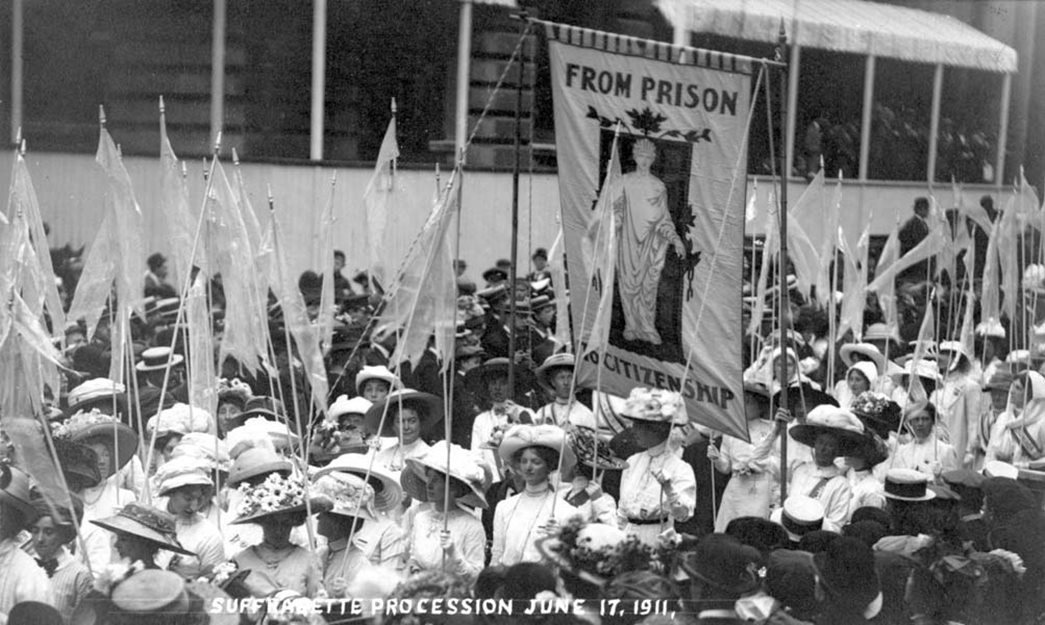
The ‘From Prison to Citizenship’ banner inthe Women's Coronation Procession
‘The Prisoners’ Pageant’ marched immediately behind the suffragette leaders. By 1911, 700 suffragettes had been to prison for their involvement in the militant campaign. (ID no.: 50.82/1660)
The Women’s Coronation Procession was one of the largest and most spectacular public events organised by the WSPU in the fight for the vote. Over 40,000 delegates dressed in national and historical costume — accompanied by garlanded floats, music and thousands of banners — marched the 4 miles from Westminster to the Royal Albert Hall, where Suffragette leaders delivered speeches.
The procession included hundreds of Suffragettes who had been to prison for their involvement in the militant campaign; and women representing all corners of the British empire (New Zealand, Australia, Canada, South Africa, Crown Colonies and Protectorates, and India).
Photographing the unique coronation procession

The Women's Coronation Procession
Organised by the WSPU this spectacularprocession was held a week before the coronation of George V with the intention of enlisting the support of the new King for the proposed Conciliation Bill. (ID no.: 50.82/1318)
The museum holds a large collection of photographs of the event, including some taken by the female press photographer Christina Broom. The procession formed a striking visual comparison with the pageantry of the King’s coronation.
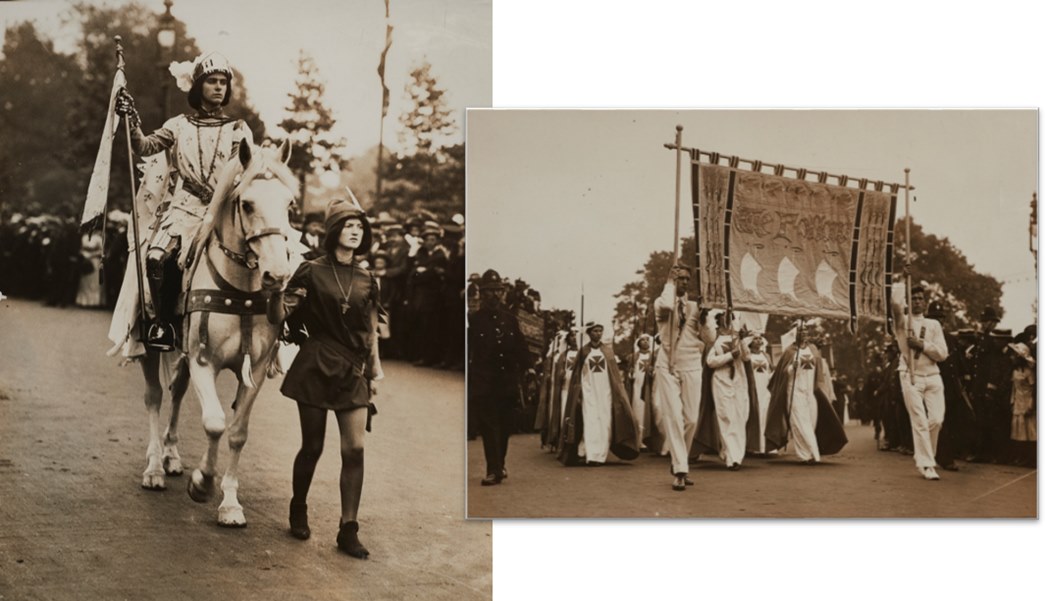
Annan Bryce as Joan of Arc in Procession of 1911
Suffragette Marjorie Annan Bryce as Joan of Arc at the Women's Coronation Procession of 17 June 1911, ahead of the Crusaders section of the procession, with the large banner, saying ‘We Follow’, carried by two men. (ID nos: 50.82/1377; NN22540)
The photographs of the different pageants representing famous historical women, the Crusades, queens, nurses and midwives, among many others, are testimony to the strength and energy of the movement. Take, for instance, the strong image of Suffragette Marjorie Annan Bryce dressed as Joan of Arc. Bryce headed the east procession that converged on Northumberland Avenue from the Embankment, ahead of the Crusaders section, with Suffragettes dressed as Crusaders, their white robes bearing the Crusaders' cross.
The 'Car of Empire'
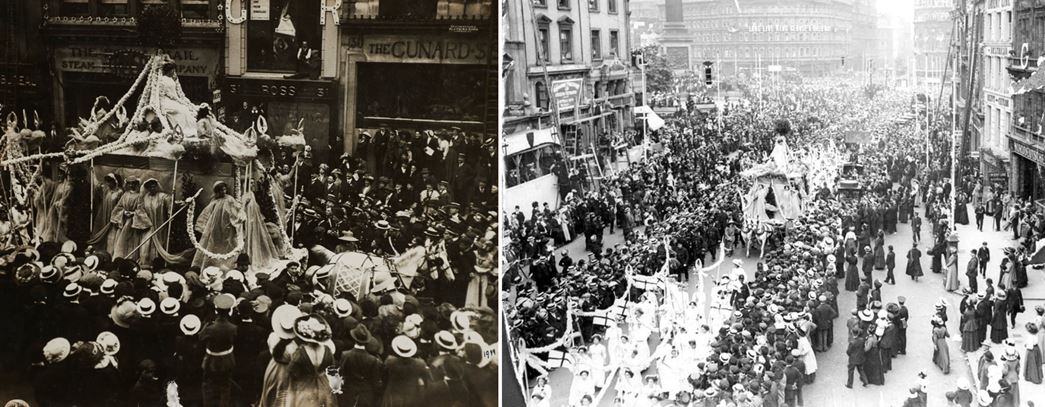
The 'Car of Empire' at the Women's Coronation Procession
The 'Car of Empire' float seen in the photographs was intended to represent 'the unity of the British Empire'. (ID nos: NN22838; 50.82/1383)
The ‘Car of Empire’ float, intended to represent “the unity of the British empire” in the fight for the vote was one of the most visually spectacular features of the procession. At the top of the float, drawn by white horses, were two figures representing East and West, and on the lowest tier were women depicting “the King’s dominions overseas”. Suffragettes from Croydon accompanied the float, which was preceded and followed by young women “carrying garlands of roses, the emblem of England”.
The Pageant of Queens comprised women dressed in historic costume representing Queens Bertha, Mary Queen of Scots, Boadicea, Anne Boleyn, Jane Seymour, Queen Eleanor, Lady Jane Grey, Henrietta Maria and Ethelflaed. The women marched behind the International Contingent & Conservative & Unionist Women's Franchise Association and in front of the New Constitutional Society for Women's Suffrage (NCSWS). In the background can be seen the banner of the society. Founded in 1910 in the aftermath of the General Election that year, the NCSWS was a non-militant suffrage organisation and specifically campaigned against government candidates at all by-elections. The society adopted a green and white colour scheme and it is likely the banner was in these colours.
Indian Suffragettes in the coronation procession
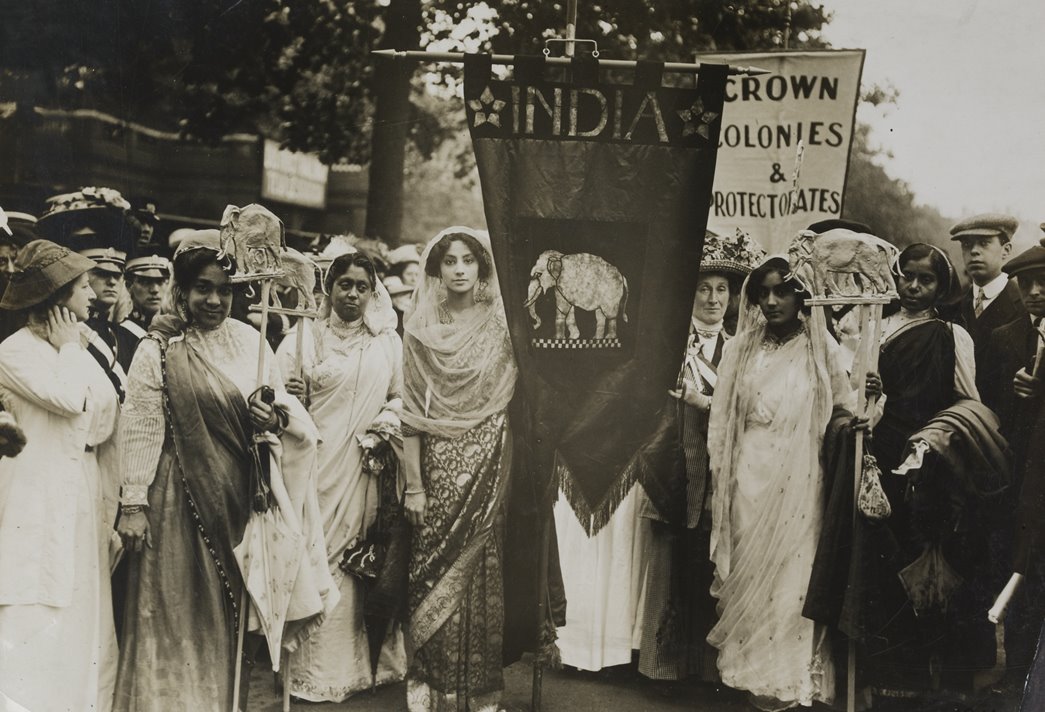
Imperial Pageant, Women's Coronation Procession
The India procession was part of the 'Imperial Contingent' and intended to show the strength of support for women's suffrage throughout the Empire. (ID no.: 50.82/1653)
The small Indian contingent was organised by Mrs Jane Fisher Unwin (the daughter of Richard Cobden). She and other representatives of the WSPU contacted Indian women living in the UK in the weeks leading up to the procession, organised the decorations and the collection of subscriptions for the elephant banner that cost between £4 and £5. The India procession was part of the ‘Imperial Contingent’ and intended to show the strength of support for women’s suffrage throughout the Empire. Annie Besant also took part in the India procession.
Among the photographs in the museum’s collection is one featuring Lolita Roy, who had moved from India to Hammersmith, London with her children in 1901. Roy, a supporter of female suffrage in India became President of the London Indian Union Society. Little is known of the other women in the contingent, but an article by historian Sumita Mukherjee identifies two other participants with Roy as Mrs Bhagwati Bhola Nauth (far left, holding the Elephant pendant) and Mrs Mukerjea. It is likely Roy’s daughters also participated in the event and may appear in the image.
Procession representing famous women in history
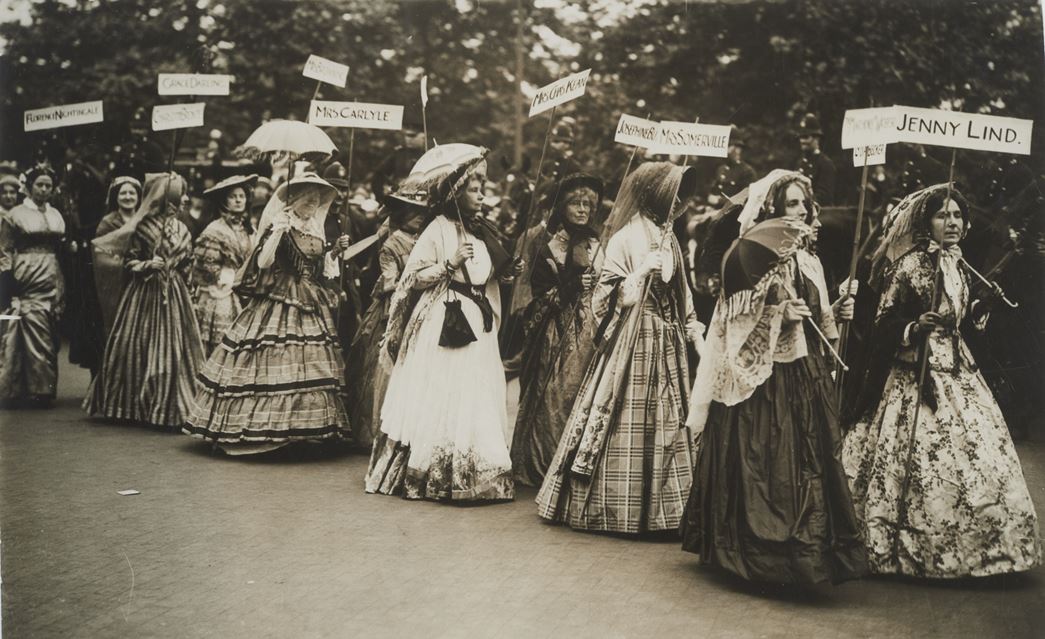
Procession representing famous women in history
For the 'Famous Women' Pageant, Suffragettes dressed as notable women from the past. (ID no.: 50.82/1325)
For the ‘Famous Women’ Pageant, Suffragettes dressed as notable women from the past, including the soprano Jenny Lind (1820-1887), Grace Darling (1815-1842) who rescued survivors from a boat wrecked off the Farne Islands, and Mrs Somerville (1780-1872) a science writer and advocate of higher education for women after whom Somerville College, Oxford, is named.
Nurses and midwives in the procession
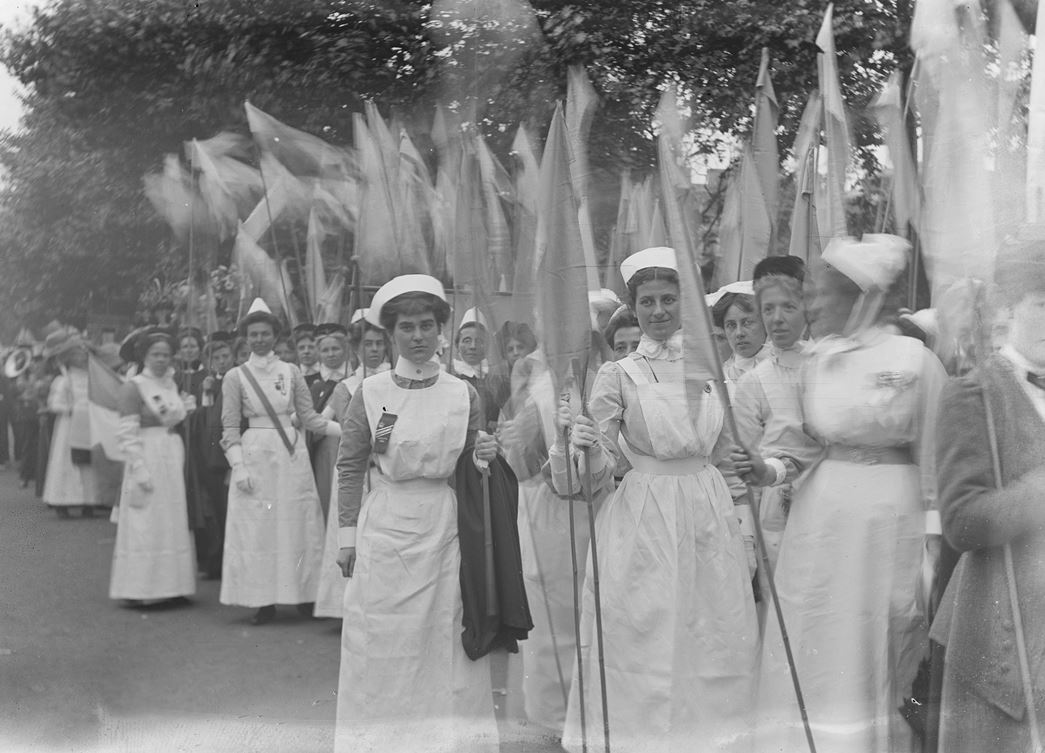
Nurses amongst the Women's Coronation Procession
A photo by pioneering photographer Christina Broom. Nurses an midwives prepare to march in the Women's Coronation Procession. (ID no.: IN1346)
The nurses and midwives were in a section of the procession that formed up on the Embankment, between Charing Cross Station and Horse Guards Avenue. Joining them were the pharmacists, women sanitary inspectors, the ethical societies, the Fabian Women’s Group, the ethical societies, Hampstead Garden Suburb and the gardeners. In the weeks leading up to the procession, the Votes for Women newspaper urged certified midwives, maternity nurses and nurses to join the procession to ensure this section “is large and representative” of the nursing profession. Those wishing to participate were asked to forward their names to WSPU headquarters and, where possible, to wear indoor uniform “which always looks so fresh and attractive”. Those wearing indoor uniform were placed at the head of the section, followed by those in outdoor uniform then nurses in ordinary dress.
Despite the impressively organised and well-attended event, which the campaigners believed proved mass support for female suffrage, the Conciliation Bill was defeated by MPs in the House of Commons and disappeared from parliamentary debate. Frustrated by the new King’s lack of support and the defeat of the bill, the WSPU leadership felt they had no choice but to take more militant action and the policy of attempting to persuade through spectacle and pageantry ended.
Take a look at the Museum of London’s photographic collection of the Women’s Coronation Procession and our Votes for Women virtual exhibition delves into the fascinating stories of seven women via powerful photographs and personal objects representing their dedication to the Suffragette campaign.
Edited by Shruti Chakraborty, Digital Editor (Content)









